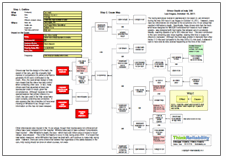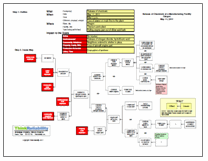By Kim Smiley
Beijing’s air pollution was at levels considered hazardous to human health for nearly a week during mid-January 2013. During this event, colorfully dubbed the “airpocalypse”, pollution levels peaked at 755 as measured by the Air Quality Index (AQI). This value is considered “Beyond Index” because it is well above the 500 which is considered the maximum AQI value. Any AQI value over 300 is considered hazardous.
This issue can be analyzed by building a Cause Map, an intuitive format for performing a visual root cause analysis. The first step in building a Cause Map is to fill in an outline with the basic background information. The impacts to the organizational goals are also listed in the Outline. In this example, the safety goal is impacted because people are reporting respiratory issues and there is a possibility of long term health problems because millions were exposed to hazardous air pollution. The customer service goal has also been impacted because of the negatively publicity that the air pollution issues have generated. The impacts to the goals are used to build the Cause Map by asking “why” questions.
Why were millions exposed to hazardous air pollution? This happened because there was air pollution produced in and around Beijing and the pollution was trapped in the city. A number of sources contributed to the air pollution. There are many coal burning factories in the area and the amount of coal burnt as a heat source has increased recently because of unusually cold weather. The number of cars in the city is also increasing at an amazing rate, with thousands more added to the city traffic daily. There is also a lot of construction in the city needed to meet the demands of such a large population. The pollution was trapped in the city because of the city’s geography and the weather. Beijing sits on a plain and is flanked by hills. If the wind doesn’t blow in the right direction to push the pollution out to sea, it will be trapped by the hills and blanket the city, which is what happened in this case.
The final step in the Cause Mapping process is to develop and implement solutions to prevent the same thing from recurring. The Chinese government did take several steps to try to mitigate the immediate problem with the air pollution by limiting the use of cars and temporarily shutting down some factories. The pollution finally cleared up as the wind began to blow, but continued efforts will be needed to prevent similar issues in the future.
To view an outline and high level Cause Map of this issue, click on “Download PDF” above.








